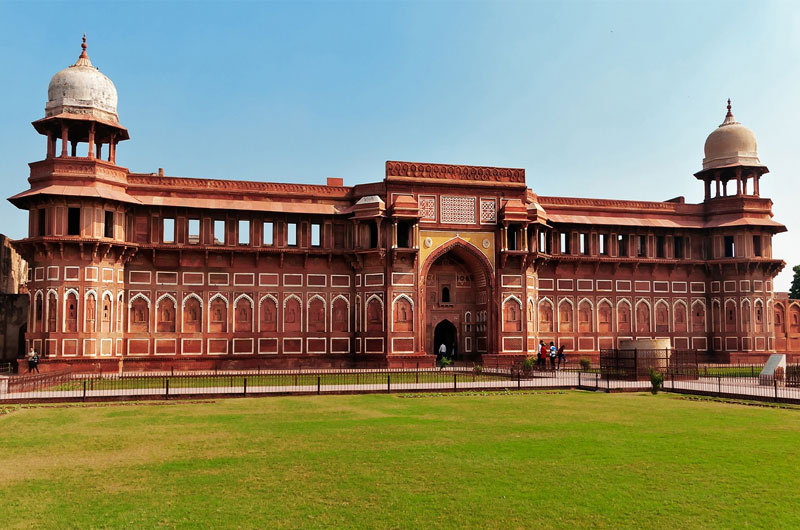
Agra Fort: A World Heritage Site
Agra Fort, a UNESCO World Heritage Site, is a monumental fortress located in Agra, Uttar Pradesh, India. This historical fortification, which served as the main residence of the Mughal emperors until the mid-17th century, is a symbol of the architectural grandeur and rich history of the Mughal era. Agra Fort, with its massive walls, palaces, mosques, and audience halls, is a prominent tourist destination, drawing visitors from all over the world.
Historical Background
- Construction and Purpose
- Originally built as a brick fort by the Chauhan Rajputs in the 11th century.
- Reconstructed in red sandstone by Mughal Emperor Akbar between 1565 and 1573.
- Served as the main residence of the Mughal emperors and a military stronghold.
- Architectural Influence
- Represents a blend of Persian, Timurid, and Indian architectural styles.
- Successive Mughal rulers added various structures, reflecting the evolving architectural preferences.
Architectural Marvel
- Design and Structure
- Encompasses an area of 94 acres.
- Surrounded by massive double walls, standing 21 meters (70 feet) high and stretching 2.5 kilometers (1.55 miles).
- Features two main gates: the Amar Singh Gate and the Delhi Gate.
- Notable Structures within the Fort
- Diwan-i-Aam: Hall of Public Audience, where the emperor addressed the public and dispensed justice.
- Diwan-i-Khas: Hall of Private Audience, used for meetings with dignitaries and nobles.
- Jahangir’s Palace: Built by Akbar for his son Jahangir, showcasing a blend of Persian and local architecture.
- Khas Mahal: A white marble palace used as the emperor’s private quarters.
- Musamman Burj: An octagonal tower where Shah Jahan was imprisoned by his son Aurangzeb; offers a panoramic view of the Taj Mahal.
- Sheesh Mahal: Palace of Mirrors, known for its intricate mirror work and ornate decoration.
- Moti Masjid: Pearl Mosque, a private mosque for the royal family, built in white marble.
Specialty of Agra Fort
- Architectural Brilliance
- Exemplifies the zenith of Mughal architecture with its intricate carvings, marble inlays, and grandiose structures.
- Showcases the fusion of Persian, Islamic, and Indian architectural elements.
- Historical Significance
- Served as the primary residence and administrative center of the Mughal emperors.
- Witnessed significant historical events, including the coronation of Akbar and the imprisonment of Shah Jahan.
Tourism Aspects
- Visitor Experience
- Guided tours available in multiple languages.
- Informative plaques and audio guides for self-paced exploration.
- Panoramic views of the Taj Mahal from Musamman Burj.
- Nearby Attractions
- Taj Mahal: One of the Seven Wonders of the World, located just 2.5 kilometers (1.55 miles) away.
- Itmad-ud-Daulah’s Tomb: Often referred to as the “Baby Taj,” known for its intricate marble inlays.
- Mehtab Bagh: A garden complex across the Yamuna River, offering a stunning view of the Taj Mahal.
- Events and Festivals
- Annual cultural festivals showcasing traditional music, dance, and art forms.
- Sound and light shows narrating the history of the fort and the Mughal era.
Impact on Locality
- Economic Significance
- Major contributor to Agra’s tourism industry.
- Provides employment opportunities for local guides, vendors, and artisans.
- Cultural Influence
- Enhances community pride and historical awareness.
- Promotes the preservation of Mughal-era crafts and traditions.
Preservation and Challenges
- Conservation Efforts
- Managed by the Archaeological Survey of India (ASI).
- Ongoing restoration and maintenance to preserve the structural integrity and historical value.
- Environmental Concerns
- Impact of urban pollution and environmental degradation.
- Measures to control air pollution and mitigate damage to the red sandstone and marble structures.
Conclusion
Agra Fort stands as a monumental testament to the architectural brilliance and historical significance of the Mughal era. As a UNESCO World Heritage Site, it not only draws tourists from around the globe but also underscores the rich cultural heritage of India. The ongoing efforts to preserve and protect this iconic fort ensure that it continues to inspire awe and admiration for generations to come.
